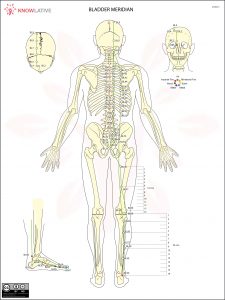The Bladder Main channel is the Yang channel associated to Water Element (水 shuǐ). The bladder is called the ‘Minister of the Reservoir’ and is responsible for storing and excreting the urinary waste fluids passed down from the kidneys. As an organ, the bladder has only this function, but as an energy system the bladder is intimately related to the functions and balance of the autonomous nervous system. That’s because the bladder energy meridian runs along the back of the body from head to heal, with two parallel branches flowing along each side of the spinal column. These four branches of the bladder meridian exert a direct influence on the sympathetic and parasympathetic trunks of the autonomous nervous system, whose condition of modern life, over activates the sympathetic system, causing tension and pain along the spine and its periphery. This tension and pain may be relieved by stimulating the flow of energy along the spinal branches of the bladder meridian. Such stimulation induces total relaxation by switching the autonomous nervous system over to the restful, restorative parasympathetic mode.
Pathway
- The external pathway of the Bladder primary channel begins at the inner canthus of the eye at BL 01 (Bright Eyes) (jingming). This point is reached by a branch that separates from the Small Intestine primary channel at SI 18 (Ceekbone Crevice).
- It ascends the forehead, there intersects with GV 24 (Courtyard of the Spirit) (Shenting) and GB 15 (Head Governor of Tears) (toulinqi), continues to the vertex and there connects with the du mai at GV 20 (Hundred Meetings) (baihui). At GV 20 (Hundred Meetings) two branches separate from the primary channel:
- one branch travels to the temporal region and intersects the Gall Bladder primary channel at GB 08 (Leading Valley) (shuaigu), GB 07 (Crook of the Temple) (qubin), GB 09 (Heavenly Rushing) (tianchong), GB 10 (Floating White) (fubai), GB 11 (Head Portal Yin) (touqiaoyin) and GB 12 (Mastoid Process) (wangu)
- the other branch penetrates deeper into the brain and reemerges at GV 17 (Brain’s Door) (naohu) or, according to some authors, at BL 08 (Declinig Connection) (luoque).
- From GV 20 (Hundred Meetings), the external pathway runs to BL 08 (Declinig Connection) (luoque) and BL 09 (Jade Pillow) (yuzhen), passes GV 17 (Brain’s Door) (naohu) and continues to BL 10 (Heavenly Pillar) (tianzhu) in the occipital region. Here, the external pathway of the channel separates into two branches:
- the medial branch runs to GV 14 (Great Vertebra) (dazhui) below the spinal process of C7 where it meets the other Yang primary channels, then continues to GV 13 (Way of Happyness) (taodao).
- From T1 it runs parallel to the posterior midline, 1.5 cun lateral to it. At the level of L2, it enters the abdomen and reaches its paired zang-Organ, the Kidney (Shen) and its pertaining fu-Organ, the Bladder (pangguang).
- The external branch runs through the gluteal region and the thigh to the popliteal fossa (BL 40 (Middle of the Crook)), where it reunites with the lateral external branch.
- the lateral branch runs from BL 10 (Heavenly Pillar) (tianzhu) to BL 41 (Attached Branch) (fufen) at the level of T2, from where it descends down the back, 3 cun lateral to the midline to the level of the fourth sacral foramen. From there it traverses the gluteal region to GB 30 (Jumping Circle) (huantiao), continues along the posterolateral aspect of the thigh and meets the medial external branch at the popliteal fossa.
- From the popliteal fossa (BL 40 (Middle of the Crook)) the channel descends along the posterolateral aspect of the foreleg to the foot
- passes the lateral malleolus
- travels along the lateral border of the foot to the lateral corner of the little toenail to BL 67 (Reaching Yin) (zhiyin). From here, a branch travels to KI 01 (Gushing Spring) (yongquan).
Features
The main functions of Bladder are:
- Gathers and eliminates fluids;
- Regulates the autonomous nervous system.

